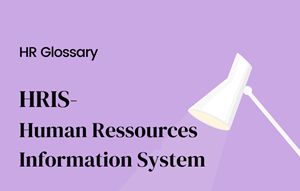Performance appraisal

[Sommaire]
What is an appraisal ?
An appraisal is a formal meeting between a manager and employee where the manager assesses the employee’s performance over a set period of time. Reviews are important for HR management as they provide a structured way to give feedback, identify training and development needs, and agree on objectives for the next appraisal period.
An appraisal may also be referred to as a performance review or performance evaluation and it is typically carried out at set intervals, for example, annually, twice-yearly, or every quarter. It is a formal opportunity to share feedback and discuss how an employee is performing against their objectives.
What are the different types of performance appraisals?
There are a number of different types of employee performance appraisals that can be used. The type that is used will depend on the organization and the purpose of the assessment. The most common type of appraisal is a managerial review, where the employee’s manager provides feedback on their performance.
The benefits of using a performance appraisal system include providing a more objective way of assessing an employee’s performance, understanding what motivates an employee, and identifying training and development needs. However, it can also be used to determine an employee’s progress toward meeting objectives and company targets.
In fact, there are some drawbacks to using a performance appraisals system, as it can be time-consuming and expensive to set up and run. They can also be subjective and may not provide a well-rounded view of the employee’s performance.
When choosing an employee performance appraisal system, it is important to consider its purpose and the available resources. The performance management process should be designed to meet the needs of the organization and the employees.
There are several different types of performance appraisals. These include :
Self-assessment appraisal :
The employee carries out a self-assessment of their own performance and objectives. They may then discuss this with their manager.
This is where the employee assesses their own performance against their goals and objectives. They then discuss this with their manager in the performance appraisal meeting. A self-assessment appraisal allows the employee to critically evaluate their own performance, which can be a powerful tool in encouraging personal development.
360 degree review :
This type of employee performance review involves Feedback from the employee’s manager, peers, and direct reports.
A 360 degree review is a type of appraisal where feedback is gathered from the employee’s manager, peers, and direct reports. This provides a well-rounded view of the employee’s performance. The benefit of a 360 degree review is that it can identify areas where the employee could improve their performance.
Here, the manager works with the employee to identify a selection of people that the employee works with. The manager then seeks feedback from these people. The feedback should come from peers, direct reports, internal customers, and senior staff.
This rounded feedback provides the employee and manager with a clearer picture of how they are viewed across the business and includes behavioral feedback as well as performance indicators.
Performance against objectives :
In this type of appraisal, the employee’s performance is measured against specific objectives that have been set for them.
These could be objectives that were set at the previous appraisal or purposes that have been set for the current one period.
This type of appraisal focuses purely on what an employee has achieved in relation to their KPIs. It is especially useful for measuring the success of initiatives or company targets. Examples of these objectives include sales targets, brand KPIs, or the number of training courses attended.
These are important aspects of understanding how an employee is contributing to an organization. However, this appraisal method misses the behavioral part of an employee’s performance.
It is typical for more than one type of appraisal to be used in an employee appraisal meeting. For example, the employee may do a self-assessment which is then reviewed alongside 360-degree feedback for a more holistic perspective.
Assessment Centre Method :
This is an appraisal system where a group of employees is assessed against a set of pre-determined criteria.
The assessment centre method is commonly used in the public sector for senior roles. It involves putting candidates through a series of exercises and tasks which assess their suitability for the role.
The benefit of this type of performance appraisal is that it provides a more objective way of assessing an employee’s performance. However, it can be expensive and time-consuming to set up and run an assessment centre.
Managerial reviews :
This is where the employee’s manager provides feedback on their performance.
A managerial review is the most common type of appraisal. It involves the employee’s manager providing feedback on their performance. The benefit of this type of employee's job performance is that it is quick and easy to set up and run. However, it can be subjective and may not provide a well-rounded view of the employee’s performance.
Psychological Appraisals :
This is where an employee’s personality is assessed as part of the appraisal process.
A psychological appraisal involves assessing an employee’s personality as part of the performance appraisal process. This can be useful for understanding how an employee works and what motivates them. However, setting up and running psychological performance appraisal systems can be expensive and time-consuming.
Behaviorally Anchored Rating Scale (BARS) :
This is where an employee’s performance is rated against a set of behaviors.
A behaviorally anchored rating scale (BARS) involves rating an employee’s performance against a set of behaviors. This provides a more objective way of assessing an employee’s performance. However, it can be time-consuming to set up and run a BARS appraisal.
Why do you need a performance appraisal ?
Appraisals are important for HR management as they provide a structured way to give feedback, identify training and development needs, and agree on objectives for the next appraisal period. They can also help to motivate employees by setting targets and objectives for them to achieve.
An appraisal is an important people management tool. Used effectively, it helps :
- Ensure employees are delivering against company objectives
- Support employees who are struggling to deliver their objectives
- Identify strong performers for potential future promotion
- A manager stays in touch with how their team performs at a deeper level.
- Support an organization’s reward and recognition program.
What is the process of getting a performance appraisal ?
Performance appraisals usually happen once a year, although some organizations do them more or less frequently. The employee’s line manager typically carries out performance reviews, but HR professionals can also do them.
Performance reviews meetings should be scheduled in advance so that both the manager and employee have time to prepare. The employee should be allowed to review their performance against objectives and identify any development needs.
The manager should also qualify for the appraisal meeting by checking the employee’s performance, gathering feedback from others, and thinking about any development needs.
Setting up performance reviews with employees is simple so long as you use the following procedure :
Invite employees to their appraisal meeting :
At a mutually convenient time with plenty of notice. Be sure to tell them why you are booking the appraisal and what you will discuss.
Performance feedback meetings should be scheduled in advance so that both the manager and employee have time to prepare.
Schedule plenty of time for the meeting :
Always more than you think you will need – and book a private room where you won’t be disturbed. It can be emotional and sometimes difficult conversations, so make sure you have time to explore everything in detail.
Appraisals should not be rushed. They should be given the time they need to ensure a full and frank discussion can take place.
Prepare the appraisal :
Ask the employee to prepare for their appraisal by reviewing their progress against objectives. It is good practice to include a self-assessment within the appraisal. The manager should check the employee’s performance, gather feedback from others, and think about any development needs.
The manager should also review the objectives that were set at the previous appraisal and should be allowed to review their performance against objectives and identify any development needs. He can also qualify for the performance management review meeting by checking the employee’s performance and gathering feedback from others.
Get feedback :
From a range of people who have worked with the employee. This provides a more rounded view of their performance.
360-degree feedback can be gathered from the employee’s colleagues, customers, and direct reports. This type of feedback gives a more holistic perspective on an employee’s performance.
The appraisal meeting should be used to discuss the employee’s performance against objectives. The manager should give feedback on areas of good performance and identify any development needs.
Prepare for the appraisal with time to spare:
Set aside time to review their progress and behaviors. Using this time to prepare for difficult discussions and potential questions your employee may have will make the appraisal run more smoothly.
Appraise performance :
This is a vital part of the appraisal meeting. The manager should give feedback on areas of good performance and identify any development needs.
Employees should be allowed to feedback on their performance. This can help to identify any training or development needs.
Set objectives for the next appraisal period :
The appraisal meeting should end with the manager and employee agreeing on objectives for the next appraisal period. These objectives should be SMART – Specific, Measurable, Achievable, Realistic, and Time-framed.
Follow up :
The performance appraisal meeting should be followed up in writing. This written record can be used to help the employee meet their objectives.
The manager should also schedule regular catch-up meetings with the employee to discuss their progress against objectives.
Performance appraisals are an important part of the employee lifecycle. They provide a way to review an employee’s progress and identify any development needs. By following the steps above, you can ensure that your organization's appraisals are carried out effectively.


